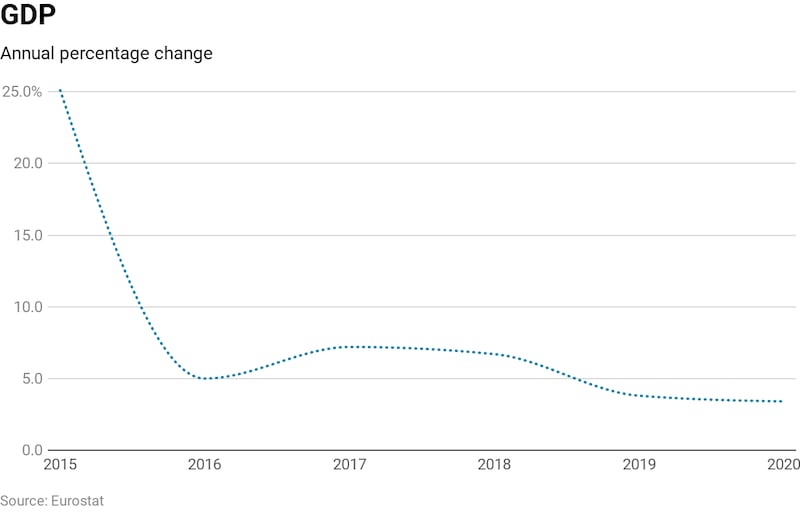The State’s GDP growth is expected to moderate to 3.8 per cent in 2019 and 3.4 per cent in 2020 on the back of a less benign external environment, the European Commission warned on Tuesday in its spring economic forecasts. The figures were part of what were a generally gloomy set of EU data, with downward revisions to expected growth for the next two years for the bloc as a whole.
For Ireland, the threat of a no-deal Brexit remains a key challenge.
“The uncertainty surrounding Ireland’s economic outlook comes mainly from external factors, particularly the terms of the UK’s withdrawal from the EU, as well as possible changes in the international taxation and trade environment,” the report says.

Uncertainty
On the domestic side, “signs of overheating could become more apparent. The huge impact of the often unpredictable activities of multinationals could drive headline growth in either direction”. it said.
In relation to the UK, the commission said that “continuing uncertainty about the UK’s future relationship with the EU27 means that business investment is likely to remain weak”.
“Annual UK GDP growth slowed from 1.8 per cent in 2017 to 1.4 per cent in 2018 due to a range of factors including falling business investment and slowing external demand. In 2018, business investment fell for four consecutive quarters – the first such instance since 2009, culminating in a year-on-year fall of 2.5 per cent in 2018-Q4,” the Commission forecast stated.
“Survey evidence suggests that this fall was largely due to the impact of uncertainty over the UK’s future trading relationship with the EU.”

However, the report is optimistic about the Irish Government’s financial position: “Based on a no-policy-change assumption, the balance is forecast to register a surplus of 0.3 per cent of GDP in 2020.”
The report notes that Ireland’s exceptional performance – 6.7 per cent growth in 2018 – is distorted by the activities of the multinationals. But it notes that modified domestic demand, a measure of domestic activity that strips out some of the effects of multinationals, grew by 4.5 per cent last year, supported by private consumption and construction investment.
It is projected to expand at an average rate of almost 4 per cent over the period to the end of 2020.
Growth
The European economy overall is forecast to continue expanding for the seventh year in a row in 2019, with real GDP expected to grow in all EU member states. GDP is forecast to grow by 1.4 per cent in the EU this year and 1.2 per cent in the euro zone.
Internal threats include a possible “no-deal Brexit”, political uncertainty and a possible return of the sovereign-bank loop, the commission warns. Externally, the slowdown in global growth, the further escalation of trade conflicts, and weakness in emerging markets, in particular China, all pose threats to the EU’s prospects.
In the short term, economic growth in Europe will rely entirely on domestic activity, the report says.
In 2020, adverse domestic factors are expected to fade and economic activity outside the EU to rebound, supported by easing global financial conditions and policy stimulus in some emerging economies.
GDP growth next year is forecast to strengthen slightly to 1.6 per cent in the EU and 1.5 per cent in the euro zone.

Pierre Moscovici, Commissioner for Economic and Financial Affairs, told journalists that "the European economy will continue to grow in 2019 and 2020. Growth remains positive in all our member states and we continue to see good news on the jobs front, including rising wages".
“This means that the European economy is holding up in the face of less favourable global circumstances and persistent uncertainty. Nonetheless, we should stand ready to provide more support to the economy if needed, together with further growth-enhancing reforms.
“Above all, we must avoid a lapse into protectionism, which would only exacerbate the existing social and economic tensions in our societies.”
Unemployment
The unemployment rate is expected to continue to fall in the EU in 2019 and is set to reach 6.2 per cent in 2020. Assuming no policy change, the debt-to-GDP ratio of the EU is forecast to fall from 81.5 per cent in 2018 to 80.2 per cent in 2019 and 78.8 per cent in 2020. While the aggregate government deficit is expected to rise from 0.6 per cent of GDP in 2018 to 1 per cent in both 2019 and 2020.
In Ireland as skill and labour shortages accumulate, foreign nationals are increasingly contributing to the labour supply, the report notes. Employment is expected to increase further, although at a moderating pace, in line with the projected slowdown in activity.
Compensation per employee increased by 2.9 per cent in 2018 and is forecast to accelerate further, supporting household disposable income.
In 2018, headline investment increased by 9.7 per cent with an increase in construction activity of 15.8 per cent, though from a low base. Investment in construction is expected to remain strong, supported by various government measures.
GDP growth in Ireland is forecast to moderate as support from the external environment weakens. Nevertheless, underlying economic activity is expected to remain robust, driven by investment in construction and positive labour market developments.
The headline government position turned from a deficit of 0.3 per cent in 2017 to a balance in 2018 on the back of a strong economy. Tax revenues, including social security contributions, were up by 7.9 per cent in 2018, driven by strong corporate tax revenues. Government expenditure increased compared to the previous year by 6.0 per cent.
A continued fall in the interest burden facilitated the deficit reduction. The government finances remain healthy, the report says, with headline balance projected to remain unchanged in 2019. Revenues “are expected to remain relatively buoyant, with many tax headings experiencing sizeable increases. Based on a no-policy-change assumption, the balance is forecast to register a surplus of 0.3 per cent of GDP in 2020”
















